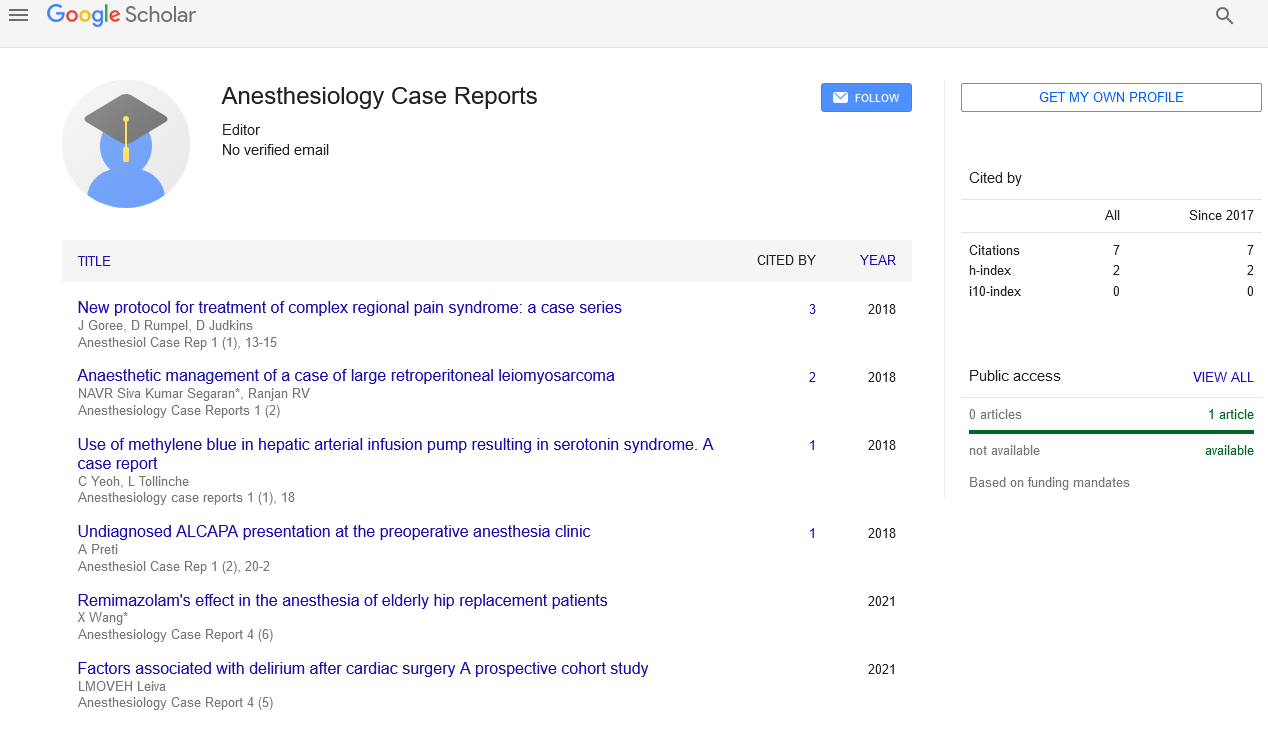Rhabdomyolysis in COVID-19 Patient
Received: 05-Dec-2022, Manuscript No. pulacr-22-5834; Editor assigned: 06-Dec-2022, Pre QC No. pulacr-22-5834 (PQ); Accepted Date: Dec 23, 2022; Reviewed: 20-Dec-2022 QC No. pulacr-22-5834 (Q); Revised: 22-Dec-2022, Manuscript No. pulacr-22-5834 (R); Published: 26-Dec-2022
Citation: Alahwal H. Rhabdomyolysis in a COVID-19 patient. Anesthesiol. Case Rep 2022; 5(6):1-2.
This open-access article is distributed under the terms of the Creative Commons Attribution Non-Commercial License (CC BY-NC) (http://creativecommons.org/licenses/by-nc/4.0/), which permits reuse, distribution and reproduction of the article, provided that the original work is properly cited and the reuse is restricted to noncommercial purposes. For commercial reuse, contact reprints@pulsus.com
Abstract
INTRODUCTION: COVID-19 is a global pandemic causing millions of infections and deaths around the world. Although it primarily affects the respiratory system, multiple organ specific manifestations have been reported. Few case reports of Rhabdomyolysis are reported in COVID-19 patients. We report a case of Rhabdomyolysis in a COVID-19 patient.
CASE PRESENTATION: 73-year-old male was admitted to the ICU for hypoxic respiratory failure requiring intubation secondary to COVID-19. His renal function deteriorated and he developed elevated creatinine, oliguria, hyperkalemia, and over a two-week period which required hemodialysis. Hospital course was complicated by shock, atrial fibrillation, ventilator dependent respiratory failure requiring tracheostomy. The patient was discharged to a long-term acute care hospital.
CONCLUSION: There are few case reports of Rhabdomyolysis in COVID-19 patients in the literature. Further studies are needed to understand the pathophysiology leading to Rhabdomyolysis in COVID-19 patients. Early recognition and treatment is essential in improving outcomes and lowering mortality
Key Words
Cardiac rehabilitation; Core components; Guidelines; Heart valve surgery; Heart valve replacement
Introduction
Coronavirus Disease 2019 (COVID-19) is a global pandemicCcausing millions of infections and deaths around the world. Although it primarily affects the respiratory system, multiple organ-specific manifestations of COVID-19 have been reported. Few case reports of Rhabdomyolysis are reported in COVID-19 patients. We report a case of Rhabdomyolysis in a COVID-19 patient.
Case Presentation
A 73-year-old male with past medical history of paroxysmal atrial fibrillation, heart failure with preserved ejection fraction, obstructive sleep apnea, hypothyroidism, hypertension, and hyperlipidemia presented with shortness of breath. His respiratory status continued to worsen and eventually required intubation due to acute respiratory failure with hypoxia in the setting of COVID-19 pneumonia. Fifteen days after presentation, the patient’s renal function started to worsen, initially from creatinine of 1 mg/dL, it continued to increase reaching a peak of 3.53 mg/dL along with hyperkalemia of 6.7 mmol/L. At the same time, his creatine kinase continued to increase reaching a high of 189,735 U / L (Figure 1). The patient was started on renal replacement therapy for acute kidney injury with oliguria, hyperkalemia, and rhabdomyolysis. The medication list was reviewed and no medications were identified as a potential cause of rhabdomyolysis. After 28 days of renal replacement therapy, creatine kinase returned to a normal level, and the patient was changed from Continuous Veno-Venous Hemodiafiltration (CVVHDF) to Continuous Veno-Venous Hemodialysis (CVVHD).
The hospital course was complicated by circulatory shocka requiring multiple vasopressors, refractory atrial fibrillation with the rapid ventricular response, encephalopathy, and ventilator-dependent respiratory failure requiring tracheostomy.
Discussion
Rhabdomyolysis occurs when the rapid breakdown of skeletal muscles happens, which in turn results in the release of cell degradation products to the bloodstream and extracellular space [1].
There are multiple causes of Rhabdomyolysis, these include trauma (especially crush injuries), inflammation as myositis, hyperthermia, metabolic myopathies, drugs, toxins, and infections [2]. Symptoms include myalgia, muscle weakness, and urine discoloration.
Laboratory diagnosis is based on the measurement of creatine kinase in serum or plasma. Rapid diagnosis and treatment are essential to prevent further complications, morbidity, or even mortality. Identification of the triggering event is of paramount importance. Early fluid resuscitation is essential and is the main therapy to prevent further deterioration. Potential complications of rhabdomyolysis include fluid and electrolyte abnormalities, renal failure, liver injury, arrhythmias, compartment syndrome, and disseminated intravascular coagulation [3].
Many viruses can lead to Rhabdomyolysis as influenza, parainfluenza, coxsackievirus, Epstein-Barr, herpes simplex, adenovirus, echovirus, human immunodeficiency virus, and cytomegalovirus [4]. The pathophysiology of Rhabdomyolysis after a viral infection is not fully understood, possible explanations are immune mediated, direct viral invasion, and myotoxic cytokines [5]. Further studies are needed to understand the pathogenesis.
Conclusion
There are few case reports of Rhabdomyolysis in COVID-19 patients in the literature, this case report aims to add to the literature and to increase awareness about this life-threatening complication. Further studies are needed to understand the pathophysiology leading to Rhabdomyolysis in COVID-19 patients. Early recognition and treatment are essential in improving outcomes and lowering mortality.
References
- Singh B, Kaur P, Mechineni A, et al. Rhabdomyolysis in COVID-19: Report Of Four Cases. Cureus. 2020;12(9):e10686. [Google Scholar] [Crossref]
- Cervellin G, Comelli I, Lippi G. Rhabdomyolysis: historical background, clinical, diagnostic and therapeutic features. Clin Chem Lab Med. 2010;48(6):749-56. [Google Scholar] [Crossref]
- Torres PA, Helmstetter JA, Kaye AM, et al. Rhabdomyolysis: pathogenesis, diagnosis, and treatment. Ochsner J. 2015, 15:58-69. [Google Scholar]
- Ayala E, Kagawa FT, Wehner JH, et al. Rhabdomyolysis associated with 2009 influenza A(H1N1). JAMA. 2009;302(17):1863-1864. [Google Scholar] [Crossref]
- Fodili F, van Bommel EF. Severe rhabdomyolysis and acute renal failure following recent Coxsackie B virus infection. Neth J Med. 2003, 61:177-179. [Google Scholar]






